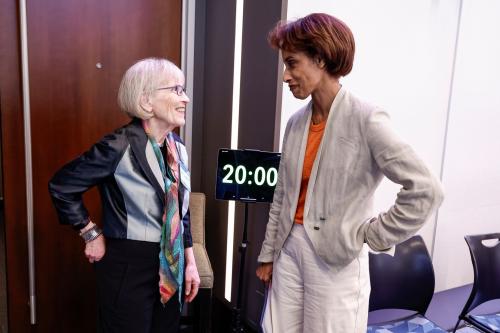Peter Edelman’s essay on improving inner-city neighborhoods contains both interesting history and a host of reasonable proposals. However, it lacks an emphasis on the major cause of problems in the inner city: personal responsibility, by which I mean the drive to finish school, shun delinquency and crime, avoid pregnancy before marriage, work steadily, stay off of welfare, and form a family through marriage. And while the policies he recommends lack evidence that they would actually work, policies that promote personal responsibility suffer from no such problem, even in the inner city. The task for the Obama Administration, and for all of us who care about improving America’s worst neighborhoods, is to expand such programs while simultaneously implementing and testing new neighborhood programs of the type recommended by Edelman.
Poverty is not the only salient feature of the types of inner-city neighborhoods that worry Edelman. Along with high levels of poverty, the worst neighborhoods also have numerous signs of social disorder. Crime and physical blight are the most apparent, but they are accompanied by low work levels among the residents, soaring high school dropout rates, low marriage rates, and high rates of non-marital births. It bears emphasis that each of these behaviors is partially or fully under the control of the residents themselves. The biggest failure of previous policies, including those proposed by Senator Robert Kennedy that are reviewed so colorfully by Edelman, was that they did too little to emphasize the importance of personal responsibility in converting inner-city neighborhoods into decent places to live.
The expansion of opportunity in America depends on principled behavior combined with wise government policies. Unfortunately, neither side of the aisle seems to fully accept this insight: Policies favored by conservatives tend to place too much emphasis on individual responsibility, while policies favored by liberals place too much emphasis on government programs. Progress will result only when the best ideas from both camps are employed to formulate policy and guide practice.
In our recently published book, Creating an Opportunity Society, my Brookings colleague Isabel Sawhill and I analyze data from the Census Bureau to show that if young people finish high school, get a job, and get married before they have children, they have about a 2 percent chance of falling into poverty and nearly a 75 percent chance of joining the middle class by earning $50,000 or more per year.
As Edelman says, we have learned a lot from previous policies. But both the data I would emphasize and the lessons I draw differ from his. As far back as the 1980s, writers such as Ken Auletta, Leon Dash, and Alex Kotlowitz wrote perspicaciously about what Auletta called the “underclass.” All these authors spent considerable time in these neighborhoods and all emphasized the multiple social problems from which the resident populations suffered. But at the outset of his seminal book The Underclass, Auletta stated my theme in stark terms:
While I don’t believe in pink pills and panaceas, I do believe in making a concerted effort to help the underclass…I came to believe members of the underclass could not succeed without practicing self-help, but I also believe they usually need a helping hand.
In 1990, given the economist’s penchant to define concisely and measure, Erol Ricketts and Sawhill used Census Bureau data to go beyond mere poverty; instead, they defined underclass neighborhoods in behavioral terms. For them, underclass neighborhoods are those well above the national average in school dropout rates, female-headed families, households on public assistance, and able-bodied men not in the labor force.
Using the Ricketts-Sawhill behavioral definition or variations thereof, researchers such as Ron Mincy and Paul Jargowsky found that these underclass neighborhoods grew rapidly in the 1970s and continued growing, albeit more slowly, in the 1980s. But then, surprisingly, a study by Sawhill and Jargowsky published in 2006 found a sharp drop in the number of underclass neighborhoods in the 1990s. Viewed through the lens of the Ricketts-Sawhill underclass definition, the decline tracked closely the sharp fall in welfare dependency. Correlation may not be causation, but it is suggestive: In the mid-1990s, the Republican Congress and President Clinton reformed welfare by strongly encouraging recipients, mostly mothers, to leave welfare for work. Mothers who did not work or prepare for work had their benefits reduced or even terminated. Further, states that failed to place half their caseload in jobs or work programs were fined. The result was that for the first time ever, the nation’s cash welfare rolls underwent a sustained decline, falling by 50 percent or more in most states. More to the point, employment among poorly educated mothers increased dramatically –between 1995 and 2000, the percentage of never-married mothers with jobs increased by an astounding 44 percent. The importance of personal responsibility was made clear.
But responsible behavior by mothers formerly on welfare or who avoided welfare is only half the story. True, this explosion of employment by never-married mothers, a demographic group with among the highest poverty rates and lowest employment rates in the nation, was unprecedented. But the most reasonable explanation of their rising employment goes beyond welfare reform. Between roughly the mid-1980s and the mid-1990s, a series of Congresses – usually on a bipartisan basis – and a series of Democratic and Republican presidents greatly improved the system of federal programs that provides support to low-income workers, notably mothers leaving welfare. These work support programs, including two tax credits, food stamps, health insurance, and child care, were reformed, expanded, or created out of whole cloth to help low-income workers escape poverty.
Yet serious challenges remain. No family can escape poverty unless it has at least one worker. The combined value of cash welfare and food stamps is less than $11,000 in the typical state, compared with a poverty level of about $17,000 for a family of three. There is no chance that Congress will dramatically increase welfare payments in the foreseeable future to enable families to escape poverty, and so basic arithmetic tells us that adults simply have to work if their families are to escape poverty.
Unfortunately, as much as we would like to think that employment and training programs can help low-income workers achieve new skills and move up the wage distribution ladder, the evidence is not encouraging. The failure of most of the mothers leaving welfare to increase their earnings substantially over time is simply the latest example of how modestly effective employment and training programs have been since they were first tried on a large scale in the late 1960s. The nation will continue to have millions of low-wage workers for the foreseeable future, many of them mothers who in the past would have been on welfare. Research shows that they will earn about $8 or $9 an hour on average. Most will find it difficult, because of the short-term nature of their jobs, the prevalence of part-time jobs, and their penchant for changing jobs, to work full-time and year-round. And most will have trouble moving up the earnings scale.
Government, therefore, will need to provide them with work-contingent benefits. Otherwise, we will be letting them and their children remain in poverty, despite their best efforts. A major tenet of American social policy should be that poorly educated parents who work full time or close to full time shouldn’t live in poverty. The combination of increased personal responsibility demonstrated by the poor who eschew welfare in favor of work, plus the work support system developed over the past two decades or so by both federal and state governments, has made this goal a reality for millions of formerly poor families.
Should Edelman’s focus on neighborhood programs be ignored? Not at all – especially if the programs focus on improving inner-city schools, remodeling housing, creating mixed-income neighborhoods, and helping inner-city residents qualify for and find work, as he proposes. There is some reason to believe that neighborhood programs of these types could provide a useful supplement to the proven effective strategy of combining work requirements with generous work support programs to increase work levels and income. The problem is that we have been trying to implement effective neighborhood strategies for several decades and still lack persuasive evidence that they increase family well-being or children’s development, or that they reduce any of the Ricketts-Sawhill markers of underclass neighborhoods.



Commentary
Family Matters: Improving Inner-city Neighborhoods
March 9, 2010